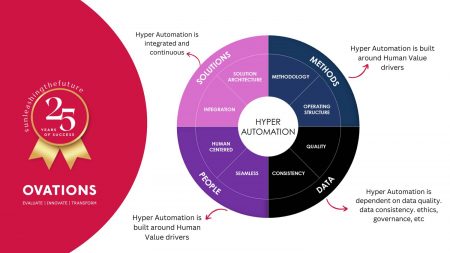 Digitalisation has affected all aspects of our lives, the way we live, the way we work, and essential to your business, the way we consume. It has altered the way customers want to interact with your business.
Digitalisation has affected all aspects of our lives, the way we live, the way we work, and essential to your business, the way we consume. It has altered the way customers want to interact with your business.
Convenience is top of mind. Customers now have raised expectations: They want to keep track of orders and tolerance levels are low. Without the necessary digital technology, it is becoming unlikely that your business can support this level of service.
Jacques Fouché, head of strategic advisory at Ovations Group, says organisations should view technology as an opportunity to compete against those businesses that have set themselves up to make the most out of digital. “Start-ups often offer competing products at low prices and can provide a great customer experience by using the latest technology and lean internal structures.”
He advises that to remain competitive in your industry and grow your market share, you should start automating the business processes that deliver value to the customer, to improve their overall experience and exceed their expectations.
Fouché identifies two key drivers of digital: customer experience (CX) and the price point of digital enablers.
“Customer experience is now recognised as the most critical factor for business success and is seen as a significant differentiator in the market. Customers expect a level of service that you can only deliver through the adoption of emerging technologies. Service levels at all points of customer interaction should be a key focus for every business.”
Digital enterprise
Secondly, Fouché states that while the cost of digital enablers has been prohibitive, cloud computing has started to break down this barrier, providing access to digital solutions to a wide range of organisations and IT budgets.
In the context of the current pandemic, remote work and new shopping behaviours have made many business owners and executives rethink digital and the role emerging technologies should play in the future of business.
A digital enterprise is one that provides customers with a physical product or service digitally, such as Uber, Takealot or even online banking, where the interaction is digital from start to finish, says Fouché.
He believes the foundation of a digital enterprise includes the following four elements:
- A set of standardised business processes across internal functions to ensure a consistent customer experience;
- The ability to predict and respond to levels of customer demand and meet their requirements on time;
- Using your customer knowledge to drive personalisation; and
- The ability to deliver new products and features quickly – digital enterprises should be able to experiment and react at pace.
“Technology is only the tool to help build a better customer experience, but being an effective digital enterprise requires changing the way your organisation works as well. It must align itself with the way customers interact with it; this will substantially improve customer experience.”

But how do businesses go about implementing digital and a customer-centric operating model? To support the required service levels and insight your customers demand, organisations can consider the following, according to Fouché:
- Optimise, automate and continuously improve business processes. Consider robotic process automation (RPA) that uses software bots to automate highly repetitive, routine tasks usually performed by knowledge workers. Adding artificial intelligence (AI) makes it possible for the bots to mimic human tasks such as pattern recognition and decision making.
- To support customer knowledge and personalisation, you need improved data processing capabilities and big data technologies that integrate customer information across all touchpoints. Supplement this with machine learning (ML) to provide the necessary predictive analytics to drive personalised marketing and fraud prevention.
- From a software perspective, transitioning from a monolithic to microservices architecture will improve scalability and flexibility and allow the digital enterprise to spin up new application features and instances, and expose APIs to partners in your business ecosystem.
- From an infrastructure perspective, a hybrid multi-cloud strategy provides the opportunity to drive cost optimisation. If you match workloads to the most appropriate computing model, you correctly optimise the workload architecture, and continuously track the spend. Consider both containers and serverless to balance your portability requirements while being conscious of vendor lock-in.
- From a people perspective, you need improved collaboration between development and operations and other stakeholders such as information security. Build on agile software development practices that closed the gap between business and developers by extending this to operations. Incorporate security and lean principles in your DevOps environment to streamline faster product delivery needed by digital enterprises.
- Lastly, solid cybersecurity and fraud strategies to protect the organisation and your customers from emerging technology threats are compulsory. It is increasingly difficult for a business to recover from cyberattacks and data breaches.
A digital-savvy leadership team is needed to drive the necessary change within the business, not only in technology but also in culture and ways of working. “For years business and IT have focused on alignment and integration, but in the digital enterprise, the executive should collaborate on people, process, and technology, in the context of customer value. These stakeholders should establish an integrated programme organised around customer journeys, where they focus on those that unlock the most value.”
The CIO needs to ensure that IT and the business are working towards the same goal: improving customer experience.
Central IT functions have, however, lost some control over IT resources and services owing to the unprecedented adoption of emerging technologies directly by the business units, in what is known as shadow IT. Technology decisions and acquisitions are gradually bypassing IT, increasing IT spend and the number of vendors to manage.
Fouché advises IT to encourage business units to collaborate with them when choosing a supplier of emerging technology. “To ensure that you achieve business value and competitive advantage, IT must become the trusted advisor and negotiator. The IT department should play a key role in identifying how you implement emerging technologies to enhance your customer experience. This includes having customers participate in the design process early on to improve the likelihood of success.”
The IT department must also identify the new skills and expertise needed and establish a sourcing model that will best support the adoption of technology trends.
“Traditional — non-digitalised, businesses — will eventually struggle to compete and meet customer expectations. For some, survival will be at stake. Traditional companies do have more legacy to deal with than new entrants, but these often work well, and they need to strike the right balance to remain competitive.”
”Putting aside the hype, I believe all businesses should at least recognise that digital can enable more effective business models. Rather embrace digital than end up unprepared.”
- This promoted content was paid for by Ovations Group




